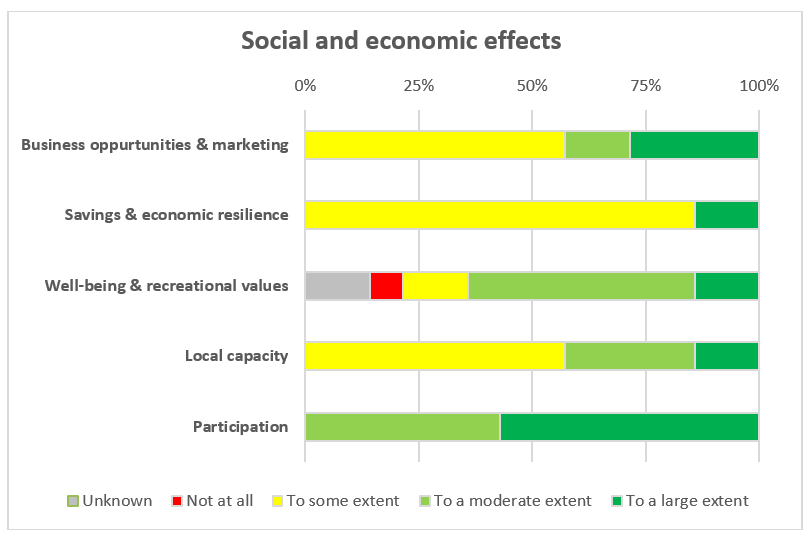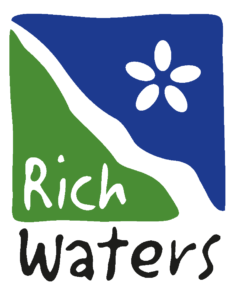Summary
This is the first of two assessments of social and economic impact of Rich Waters projects. In this phase eight projects were assessed, in next phase another eleven projects. The assessment focused on a set of categories identified as relevant:
- Employment
- Business opportunities and marketing
- Savings and economic resilience
- Well-being and recreational values
- Local capacity
- Participation
- Gender, equality, and integration
The data used for the assessment were project reports, economic reports, and a survey to, and interviews with, the eight projects (project leaders as respondents). Three different types of data were included in the assessment based on different methods for data collection: (i) measured data from economic reports, (ii) estimated impact from questionnaires, and (iii) probable impacts mainly from questionnaires. Because of the lack of existing measured data (such as statistics, economic report, questionnaires, etc.) of social and economic impacts of the projects implementation, most of the results are based on how the respondents perceive the impacts as reported in the survey. The survey was based on the seven categories of social and economic impacts, including closed-ended question based on statements and magnitude scales (not at all, to some extent, to moderate extent, to a large extent) as well as open-ended questions where respondents were asked to motivate and explain the closed-ended questions. Seven projects responded. The eight projects assessed were:
- C6.2 Julmyra Horse Center as a showcase for nutrient load reduction in horse keeping
- C10.2 Multifunctional waterpark i Västerås
- C10.3 Storm water treatment waterpark in Uppsala
- C13 Stopping internal phosphorus leaking – a full lake treatment (in lake Norrviken)
- C16.1 Construction of fish passage and demonstration site at Slottsbron
- C17.1 Longitudinal connectivity in Rällsälven river – construction of fauna passage Rällsälv hydropower plant
- C17.2 Longitudinal connectivity in Hedströmmen river – construction of fauna passage Östtuna hydropower plant
- C20.1 Limit the use of toxic anti-fouling by boat bottom washing
Employment. The eight projects employed 53 full-time equivalents during the period 2017-2021. 89% of the total costs of all projects are related to external actors (not partners in Rich Water project) for constructing the physical measures. 5% of the total employments are related to consultants of analysis services, and 6% are employments at the contractors of the projects. Hence, 94% of the employments are related to external actors. Two of the projects stand for approximately 80% of these employments, mainly due to high costs for measures construction and physical measures. Of the employments among external actors approximately 65% of these are local enterprises (within current municipality) which indicate that the implementation of the projects has stimulated local markets. The result from the survey indicated that all respondents expect the implemented measures of the projects to lead to future employments, due to new tasks for maintenance service, knowledge transfer, and new business opportunities.
Based on the survey to, and interviews with the projects, the estimated social and economic impacts were explored, and the results are summarized in Table 1. 57% of the respondents answered the projects have enable business opportunities and marketing to “some extent”, 14% to a “moderate extent” and 29% to a “large extent”. The higher magnitude of agreement of the statement were mainly related to the marketing opportunities for the contractors, by getting good examples of measures to use in communication of sustainability efforts of both municipalities (local authorities) and private enterprises. 86% of the respondents answered that the implemented projects will entail savings and economic resilience to “some extent”, and 14% (one of the projects) to a large extent. Many of the projects have implemented measures that strengthen or created new ecosystem services, such as improved systems for stormwater management, which could imply savings or future values for the local society. Further many projects express that from the new solutions tested and implemented in the projects, knowledge gains will make similar measures in the future to be constructed in a more cost-effective way. The project that estimated savings to be great, has created a fauna passage that will reduce the risk of flooding in a city environment in the future, which often are related to great costs and discomfort for citizens.

The category of well-being and recreational values is the most varied in terms of results from the survey. This is mainly due to the variety of the measures that the projects have implemented. The chart includes both statements on increased quality of recreational values, and increased availability. 50% of the respondents answered that the project has led to increased well-being and recreational values to a “moderate extent”, 14% have answered to a “large extent”, “to some extent” and “unknown”, and 7 % answered “not at all”. Great recreational values have for example been created through the new water parks and through the improvement of water quality in a lake.
In the category of local capacity, the question concerned to what extent the projects have entailed a strengthened collaboration among local partners, or new collaboration patterns. 57% of the respondents answered “to some extent”, 29% to “a moderate extent” and 14% to “a large extent”. The respondents mention both improved collaboration in existing networks (such as between municipalities), but also new cooperation between municipalities and private actors and NGO’s that the implementation of the measures have required.
The category participation concern to what extent the projects have reached and involved its target groups. Here 57% of the respondents have estimated participation to a “large extent” and 43% to “a moderate extent”. Both improved local capacity and participation of target groups can facilitate future projects and continuation of common projects related to water quality and environmental measures.
The category gender, equality and integration were assessed through questions on distribution of effects related to the other social and economic categories (mainly employment, and well-being and recreational values). For the gender aspect in correlation to the employment, women dominated employment among the contractors and project leaders (65%), whereas men dominated the external employment, mainly due to high degree of construction services. Some of the projects have involved aspects related to equity and integration as a part of their projects, both in terms of focusing on educational purposes of the measures, and in the location of the measures close to socioeconomic weak areas. Highlights. Some of the social or economic impacts assessed are indicating great potential for valuable and significant benefits for the society.
- Savings: C17.1 – great economic benefits in avoidance cost for future (potential) flooding.
- Recreational benefits: C13 – improved water quality in well used lake for recreation. Citizens’ very positive to development. Great socioeconomic benefits related to similar projects in urban areas.
- Equality: C10.2 – new recreational area with good accessibility, by the constructed water park (wetland). Developed also for educational purposes together with schools. Internship with long-term unemployed was involved in construction and development of the park.
- Participation: C6.2 – measures at horse center to reduce nutrient leakage. Great participation of, and outreach to similar enterprises or organizations, give potential for distribution of similar measures at other horse centers.
